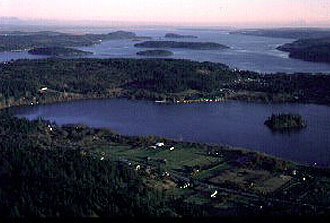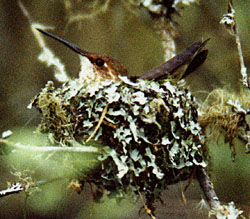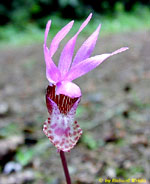

The San Juan Islands are a group of several hundred islands, islets, rocks, and reefs located in the northwest corner of Washington State between southern Vancouver Island and the United States mainland. Its combined landmass is less than 175 square miles. Four of the largest islands (San Juan, Orcas, Shaw and Lopez Islands) are served by passenger ferries from the mainland. All other islands are reachable only by boat or (in some cases) light aircraft. Most of the smaller islands are uninhabited.
Island terrain is varied and the geology is complex. Essentially, the islands are the tops of mountains surrounded by the marine waters of the Salish Sea. Fourteen thousand years ago, these mountain-tops were covered by a mile of ice.
 The islands
are exquisitely beautiful with a combination of marine, shoreline, forest,
farmlands, and prairie habitats. A multitude of animals inhabit the surrounding
waters. Most visible are the marine mammals-- Harbor seals, Orca whales,
River Otter, and Dall's porpoise. Bird life is abundant. Bald Eagles, Peregrine
Falcon, Cooper's Hawks, Sharp-shinned Hawk, Red-tailed Hawks, and Horned
Owls are some of the common raptors. The waters attract a plethora of wintering
sea birds and Trumpeter Swans grace our inland lakes and ponds. Springtime
sees the return of migrants, such as the little jewel, the Rufous Hummingbird.
Deer, fox, rabbits, and many smaller mammals abound on many of the islands.
The islands
are exquisitely beautiful with a combination of marine, shoreline, forest,
farmlands, and prairie habitats. A multitude of animals inhabit the surrounding
waters. Most visible are the marine mammals-- Harbor seals, Orca whales,
River Otter, and Dall's porpoise. Bird life is abundant. Bald Eagles, Peregrine
Falcon, Cooper's Hawks, Sharp-shinned Hawk, Red-tailed Hawks, and Horned
Owls are some of the common raptors. The waters attract a plethora of wintering
sea birds and Trumpeter Swans grace our inland lakes and ponds. Springtime
sees the return of migrants, such as the little jewel, the Rufous Hummingbird.
Deer, fox, rabbits, and many smaller mammals abound on many of the islands.
 The flora
of the islands is diverse, given the varied landscape. Rare and endangered
plants, such as the Brittle Cactus, the Naked Broomrape and the Golden Paintbrush,
can be found in specialized habitats. The Garry Oak, a tree scarce in Washington,
has a foothold in the islands. Spring flowers, such as the Buttercup, Chocolate
Lily, Shooting Star, Blue Camas, Calypso Orchid, and a host of other species
display their colors on the island's prairies and forest.
The flora
of the islands is diverse, given the varied landscape. Rare and endangered
plants, such as the Brittle Cactus, the Naked Broomrape and the Golden Paintbrush,
can be found in specialized habitats. The Garry Oak, a tree scarce in Washington,
has a foothold in the islands. Spring flowers, such as the Buttercup, Chocolate
Lily, Shooting Star, Blue Camas, Calypso Orchid, and a host of other species
display their colors on the island's prairies and forest.
The Native Americans, also, have imprinted the islands with their historical presence. From the archeological evidence it is apparent that the Lummi and Samish Indians used the islands as a summer cornucopia. They fished for plentiful salmon, harvested shellfish, hunted, and managed areas for camas production, a root plant that was important in their diet.
The combination of forest, farmlands, and marine habitat make the islands a mecca for tourists and for people who seek to work and retire in island "paradise." The people who migrate to live in the islands are as varied as the habitat and ideas concerning how the land should be "managed" are likewise as diverse.
Land ownership in the islands is a collage of ownership. National Parks, State Parks, Department of Natural Resources Recreation Areas, Bureau of Land Management, National Wildlife Refuges, San Juan Preservation Trust, San Juan County Land Bank, and The Nature Conservancy, along with private landowners, all have an interest in land use issues here.
The San Juans are suffering from the all too common pressure that results from increased population. San Juan County is now one of the fastest growing counties in the State of Washington. It's population has almost tripled in the last fifteen years. The tourist industry brings thousands of people to the islands each day during the summer months. The land is under constant pressure to be divided up into smaller and smaller parcels. In some places the rural landscape has been transformed by suburban development. In recognizing the population problem the State passed House Bill 1919,known as the Growth Management Act (GMA) in an effort to manage population growth. On a county level, local voters passed the land bank tax for acquiring conservation lands. Private organizations such as San Juan Preservation Trust and the Nature Conservancy have acquired lands and initiated conservation easements. But despite these efforts, land is being lost to development at a rapid rate.In the process there is increased negative pressure on the natural environment. Rare plants and animals are becoming more and more endangered. Also, increased recreational boating is impacting the marine environment.
As important as government regulation is to the preservation of the environment, it is always subject to the political whims of the voter and the politician. There are no guarantees that lands controlled by public agencies cannot be sold or traded at a later date. A political change in climate may result in the trading or sale of a piece of "conservancy" lands to balance the budget or to build up the public coffers.
Efforts at conservation by private agencies are more secure. Buying lands outright or getting conservation easements makes development or land-use change more difficult. But these agencies, along with the public agencies, tend to go after large land units, getting the most "bang for their buck."
Small ecosystems, such as exist in the varied terrain of the San Juan Islands, are, more often than not, overlooked. The little islands, the nooks of crannies of cliff faces along the shoreline, the snippets of prairie lands, or a small stand of old growth trees, are places where unique plants and animals make their home. These areas usually are not recognized as important natural areas and in need of preservation.
To prevent loss of these important small areas three things must be done. First, there must be a heightening of public consciousness concerning the problem. This web site is one attempt to do just that. Secondly, a mechanism must be put in place to preserve these areas. Instead of regulation it is proposed that incentives, such as tax breaks, be established to encourage the landowner to preserve ecologically important areas. And, thirdly, citizens must be constantly sensitive to proposed changes in land-use by public agencies, and, they must be willing to act to forestall any detrimental change. An example of this was the action in 1997 by a group of citizens, who, in response to the alert sounded on a web site by Terry Domico, descended on Olympia and stopped the development of a campground on Gossip Island, a small, ecologically important island near Stuart Island. It wasn't that the developers, WA State Parks, were out to pillage the place, but they were simply unaware of its natural importance.
Spearheading this concern for San Juan Islands "small" places, is Terry Domico. Terry is a trained biologist, who is also a writer and a photographer. He has published the popular "BEARS OF THE WORLD", a work that took him to the four corners of the world to do research. It is published in four languages and has had 14 editions. More recently is his book, "KANGAROOS: THE MARVELOUS MOB", which took him into the wilds of the Australian Outback. Terry also wrote "WILD HARVEST: EDIBLE PLANTS OF THE PACIFIC NORTHWEST. He was the photographer for the book, "THE NATURE OF BORNEO".
On a more local issue, he wrote an important monograph on the Native Prickly-pear Cactus in the San Juan Islands. Terry has contributed articles to National Geographic books and he has also published articles for such magazines as "The Smithsonian" and "Natural History." Terry runs a business that does habitat assessments in the Puget Sound region of Washington. He has developed a money-saving environmental assessment tool called the Rapid Assessment Program, which has been used both in Australia and Malaysia.
Terry is a long-time resident of the San Juan Islands. Twenty years ago he began to see the need to do an assessment of the sensitive areas of San Juan Island. About twelve years ago he and group of volunteers began to get serious. After normal working hours, Terry and his volunteers have scoured the islands, assessing and identifying small ecologically significant area that need protection. His criteria for designation includes: 1) The area must be relatively undisturbed, complete ecosystems. 2) The flora must be native, not exotic immigrants from foreign lands. 3) There must be some level of public access to the site. For example, the area should be open to small groups of organizations, such as a school or a conservation society, for study. 4) It is a site that may be in danger of future development or misuse.
At this point Terry is in the stage of heightening public awareness, although he has also initiated a dialogue with county government about an incentive program. To accomplish his goal, he wants to do what he does best, i.e. publish a book about the sensitive areas of the San Juan Islands.